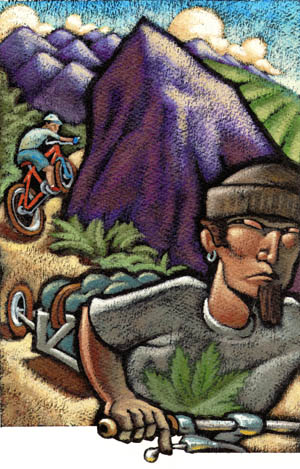 Mountain Bikes and Cash Crops in the San Bernardino Mountains
Mountain Bikes and Cash Crops in the San Bernardino Mountains
The first time I heard the term B.O.B. was when Clem and I were discussing a planned five-day mountain bike extravaganza across Santa Catalina Island. He explained how a “Beast of Burden”, or B.O.B. for short—a one-wheeled mountain bike trailer—might come in handy for hauling around essential camping gear on the dirt roads that traversed the island. I envisioned the mountain bike version of a fifth wheel, the perfect place to stash important stuff like tent, sleeping bag, filet mignon, smoking jacket, and six packs of choice microbrew. “Roughing it” instantly took on an entirely different meaning.
Only a few days later, I saw my first B.O.B.—actually a pack of four of them, about a block from home. On the daily grind up the hill to clean my favorite singletrack, suddenly four mountain bikers appeared coming down, each towing an unusual-looking one-wheeled trailer. Each trailer carried a rather large, tightly secured load. My amazement at the multiple B.O.B. sighting quickly gave way to close examination, as something about these dudes was not quite right. Four bikers, just coming off the mountain, carrying big loads—obviously, they had come far. Maybe all the way from Big Bear? No, even that journey wouldn’t require an overnighter, being about 20 to 25 miles on fire roads and jeep trails, and the majority of it downhill.
Their bulging loads were carefully concealed under small tarps held tight with bungee cords, not giving me the slightest hint as to what they may have been carrying. Perhaps my suspicions were driven by memories of my own guilt. I remembered about eight years prior, when Jeff and I rode into the same area on our mountain bikes, me hauling a “kid trailer” with a backpack strapped in the seatbelt and a child’s helmet propped on top to look vaguely like a kid. We kept yelling back to our faux child, “Are you OK back there, Amanda?,” trying hard not to laugh. But it was all a clever ruse to get up into the orange groves and liberate 100 pounds of ripe oranges from the oppressive citrus farmers of East Highlands. We hauled the oranges down in the trailer and had fresh-squeezed orange juice for several days, until we could no longer stomach the thought of it.
Maybe the B.O.B. crew was up to something similar. I tried to imagine orange-sized bumps revealing the secret payload under their tarps, but to no avail. Then I noticed their attire: baggy shorts and t-shirts. While this was indeed my mountain biking wardrobe of choice, it was not what I’d imagine from hard-core dudes each pulling a personalized B.O.B. No helmets or gloves either, which seemed highly inappropriate for their obviously lengthy journey. This was getting real strange.
As they passed close enough for a greeting, I attempted to exchange pleasantries with my mountain bike brethren, but was not obliged with even momentary eye contact, let alone a return “howzit”… A serious breach of mountain bike etiquette; the bastards had snubbed me! Just then, the loser in the lead awkwardly blew his right foot out of his toe clip and almost bit the pavement. Amateur! Just what the hell was going on?
And with a flash of dirt-encrusted metal, they were gone. I continued up the hill, figuratively scratching my head for a moment or two. But the B.O.B. incident was quickly filed to memory as I became entranced by the rhythm of the uphill grind, then the liquid-like flow through the twisting singletrack, followed by the rush of air against my face as
I accelerated quickly down the exit fire road.
—–
Southern California’s East Highlands area used to be the Orange Basket of the United States. Forget “Orange County”, and forget Florida. This place was once the undisputed king. Enough fiber left the fertile loins of the Inland Empire to keep half the world regular through the next millennium. But alas, it was not meant to be. Diseased rootstock was used for the majority of the trees, and they started dying. Highland and nearby Redlands still sport stands of citrus groves, but they are a mere shadow of the greatness which once was.
In addition to the climate being just right for growing citrus, there was also a readily available source of water nearby—the San Bernardino Mountains. Nestled on a rough plateau between the mountains and the valley, Highland has first dibs on the cool, clear runoff from the mountains.
Getting water down the mountain and to the groves may sound simple enough, but in fact demanded miraculous (for the time) feats of engineering. Flumes (rock and cement-lined trenches), and later buried pipes, plucked the sweet water from its source high in the canyons, then snaked their way for miles down the foothills for distribution amongst the thirsty groves. A break high in the distribution system could spell disaster, as it might go unnoticed for some time.
The flumes were built long before cars “blessed” the area with noxious fumes, wide roads, and other destructive influences. So the flumes were monitored and maintained on foot, on trails built alongside them. To this day, many of these footpaths remain as the only access to the aging flume system. More recently, a few hard-core mountain bikers have discovered that these trails make for kick-ass singletrack.
—–
Plunge Creek has three distinct identities. Lower Plunge Creek is a beautiful riparian setting, reached from my house by a mile-long flat ride on horse trails and dirt roads—a favorite when I take my kids on a ride. Middle Plunge Creek follows an open flume for a while before it is transformed into a singletrack death wish—imagine a half-foot-wide, sloping, hardscrabble trail where one false move means 60 feet of air, followed by a sudden stop in a few inches of water. It’s something a sane person might only try once in their lifetime (I’ve done it twice in eight years…and swear, never again). But if you’re looking for great local singletrack that’s challenging but you’ll have a great chance of surviving, Upper Plunge Creek is the destination of choice.
The entry is a harsh uphill two miles on a steep and sometimes sandy dirt road, then a quick little turn to the right that you might easily miss if you didn’t know exactly where to look—the start of the singletrack. Most people really enjoy the first two or three miles of singletrack on the Upper Plunge Creek trail. It’s generally well-maintained, although it has its fair share of washouts and hike-a-bikes. It follows an old buried clay pipe that contours around the mountain as it makes its way down from high up the mountain. The pipe features intermittent breather holes—holes which make for interesting obstacles, all the more strange because of the huge sucking sounds they sometimes make as you whisk by.
It can be an immensely peaceful ride. Far from the noise of the suburbs, you hear the occasional jet fly overhead, but mostly you hear yourself gasping for air, your heart pounding heavy in your chest, and your bike straining against the dirt and loose stone.
I once saw a bobcat on this trail, and have seen the footprints of many deer. A few months ago, a rattlesnake rattled violently behind a bush, just inches from our feet as Dave, Clem, Mike, and I descended. I’ve never actually seen a mountain lion up there, although many others have. Add to that the sheer drops of 100 to 200 feet off the side of the trail in spots, and it really adds a sense of adventure to the place. If something happened, it’s rugged enough that they might never find your body.
A significant landmark along the trail is affectionately known as “The Jacuzzi”—a large, deep, square stone holding tank where the water collects momentarily before resuming its controlled plunge down the mountain. But don’t let the nickname fool you; The Jacuzzi is ice cold, and it’s not something you’d ever want to swim in. The water is dirty, and the suction caused by the water flowing into the exit pipe is probably strong enough to rip your arm off. The last time I was there, I noticed a piece of PVC pipe and an empty bag of chemical fertilizer lying next to The Jacuzzi. I hypothesized that workers from the groves miles below may have carried the fertilizer up the long trail and poured it into The Jacuzzi to let it dissolve into the water for better dispersion down below, but it seemed like a long shot. And I still had no plausible explanation of why someone would walk several miles into no man’s land carrying a 10-foot section of PVC pipe.
—–
Helicopters were unusual enough in the neighborhood that whenever I heard one, I’d make an effort to watch it. In late August, I noticed a huge increase in local air traffic; several helicopters a day buzzed the hills to the north and the east, following a flight path I had never noticed before. This continued unabated for about two weeks, and then abruptly stopped. A short time later, I was reading the newspaper before my morning ride, and the headline screamed out: Record Pot Bust in Mountains.
Working on an anonymous tip, San Bernardino County Sheriff’s Deputies and U.S. Forest Service officials had located a large pot farm in the San Bernardino Mountains. Water siphoned from a nearby irrigation pipeline guaranteed the place a constant supply of water. The location was so isolated, if law enforcement had not received the anonymous tip, the farm surely could have operated unnoticed for years. The location: Upper Plunge Creek.
In less than a month, Sheriff’s Deputies had raided three more pot farms within ten miles of Plunge Creek. In all, nearly 50,000 pot plants, with a street value of more than $150 million, were seized. Officials say the combination of near complete isolation in close proximity to civilization with a readily available water supply makes the canyons behind the orange groves an idyllic location for the growing of California’s number one cash crop. All four of the pot farms were linked when officers noticed similar looking bags of chemical fertilizer at each location and checked the serial numbers. Turns out they were from the same batch at the same manufacturing plant.
At one of the farms, officers found two armed Mexican nationals, living in a well-stocked camp featuring all the accouterments, including a tomato and jalapeno pepper garden—all the fixin’s for fresh salsa. And the caretakers had spent hundreds of man-hours cutting a new trail through two miles of impenetrable chaparral—future singletrack!
—–
The PVC pipe. The empty bag of fertilizer. The pieces of the puzzle were starting to fit together. But what about the B.O.B.s? Just what were those guys carrying under those tarps anyway?
—–
This story first ran in issue #77 (02.15.00) of Dirt Rag magazine. It also appeared in A Life Outside in October 2007 (1st edition) and September 2012 (2nd edition) and was reprinted in Confessions of a Weekend Warrior: Mountain Biking Stories (June 2013). While it is purely speculation the guys with the bike trailers were the same ones responsible for the pot farm, all of the events in this story did actually occur.
